Installing a septic tank in winter: step-by-step instructions and analysis of possible errors
Construction work is carried out at any time of the year, despite the cold or heat. It is not always possible to choose a season that is comfortable for work, since the deadlines for the completion of the facility are running out.
In general, the installation of a septic tank in winter is carried out in the same sequence as at any other time of the year, however there are a number of features that should be taken into account during installation. Knowing the basic rules for installing and connecting a treatment plant, it will be possible to avoid a number of mistakes and prevent breakdowns of expensive equipment, agree?
The article outlines the pros and cons of installation work in the cold season, the common mistakes of inexperienced craftsmen. Phased installation instructions are also described and recommendations are given for preserving the septic tank for the winter.
The content of the article:
Installation of a septic tank in winter - pros and cons
Some mistakenly assume that it is impossible to install a septic tank in the winter, and are waiting for spring to begin installation. However, this is not the case. You can put a septic tank on your site at any time of the year, moreover, in some situations, installation can only be done in winter. This happens when the groundwater level is high.
In the spring, during the mass melting of snow, the UHW rises to critical levels. A situation may arise when a newly dug pit fills with water at high speed. And then about the installation is out of the question.
So it is better to suffer a little with the upper frozen layer of soil - it usually does not exceed 100 cm.
There are a number of advantages that make it necessary to choose this particular time of year for installation:
- low workload of builders;
- low prices for materials;
- lack of vegetation on the site.
It's no secret that winter is a "dead" season for builders. Demand for services is falling and prices have to be reduced in order to attract customers. You can take advantage of this and save a little. The cost of renting construction equipment and workers' services can be reduced by 10-20%.
Demand in construction stores and treatment plant manufacturers is decreasing. Often there are profitable promotional offers and other bonuses.
Installation of a septic tank requires digging a large pit in volume and, accordingly, excavating a large volume of soil. This requires free territory, and if your site is landscaped, a lawn, flowerbed or garden planted, the installation process will nullify all your efforts.
Another thing is the installation of a septic tank in the cold season, when there is no vegetation.

Avoiding Common Mistakes
When installing a septic tank in the winter, mistakes are made that can subsequently cause a breakdown or poor-quality operation of the septic tank. In winter, daylight hours are short, the conditions on the street are not the most favorable for work, I want to finish the installation as soon as possible. Such a rush often increases the number of errors and misses during installation.
The most common mistakes that workers make during the installation of a septic tank in winter:
- lack of fixing plastic containers;
- non-compliance with the rules of backfill;
- lack of ventilation;
- improper placement of the septic tank;
- lack of insulation.
To avoid possible troubles, it is better to prepare in advance and take into account all the nuances.
Error No. 1: location without taking into account the requirements of SES
The placement of a septic tank should be determined not only by the desire of the owner of the site, but also by sanitary standards that clearly regulate the installation of such structures on the site.
In particular, the sanitary area around the installation site is limited. Its radius is 15 m. In the sanitary zone, it is unacceptable to find water intake points, 50 m should be measured to the well or well.
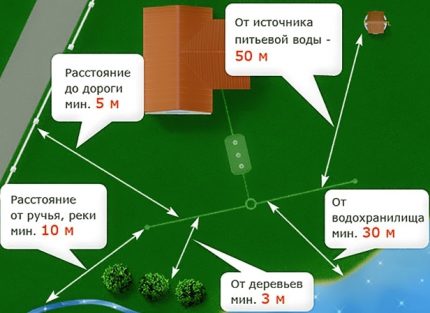
At the same time, residential buildings should be located no closer than 5 m from the septic tank. The distance to the road and the border of the plot is also limited to at least 2 m.
Regarding natural reservoirs, SNiP also makes its own adjustments:
- from 30 m to water bodies with stagnant water;
- from 10 m to flowing water bodies.
It is also undesirable to install a treatment plant in a lowland. In winter it will be imperceptible, but with the onset of heat, meltwater will flood the foundation pit and the septic tank itself, hindering its operation.
Mistake number 2: lack of fixing
If we are talking about plastic septic tanks, which are in a wide range on the market, you need to understand that the container will not be filled with drains 100%. In any case, the part will be empty, which means it will be filled with air.
With a high level of groundwater, a plastic container, 20-30% filled with air, will float like a float.
At the time of installation (in winter), the water supply will be minimal, but you need to be prepared for the fact that in a couple of months spring, thaw, and a significant increase in groundwater level will occur. And here the fun begins.
Water will gradually fill the foundation pit with a septic tank, and that, in turn, will begin to float. Yes, it will not go anywhere from the foundation pit, but even a minimal change of position of 5-10 cm in any direction will almost certainly lead to the depressurization of joints, a violation of the connection to the sewer pipe, ventilation, etc.

To prevent this from happening, experienced installers advise to “anchor” the tank using a concrete slab installed at the bottom of the pit. An alternative option for installation in winter is drilling wells and pouring them with concrete. Then, anchor bolts are placed in the body of the obtained rods, and a plastic septic tank is attached to them.
Mistake # 3: backfilling with ordinary soil
In winter, the topsoil freezes. Freezing depth (GP) may vary significantly depending on the region. Typically, this indicator is close to 1-1.5 m. In order not to bury the septic tank completely below the GP, it is customary to fill the foundation pit not with ordinary soil, but with sand or a sand-cement mixture.

However, sometimes when filling a septic tank, they make a common mistake - they do not sift the sand. It would seem that this is not a big deal.
However, even a small fragment of rubble, accidentally found to be closely pressed against the wall of the plastic container, creates quite strong concentrated point stresses in the plastic under the weight of a meter layer of soil. The result is a crack or hole in the body.
The septic tank will be depressurized. And if suddenly the plastic does not stand, and the crack goes further, the whole structure may break. In this case, the repair will no longer help, it remains only to completely change the equipment and install it, looking back at the bad experience.
Mistake # 4: lack of ventilation
In winter, installation is often limited to the construction of the foundation pit, installation of the septic tank structure itself and the connection of communications. But ventilation is often forgotten.
This omission can cause excessive gas formation and, as a result, unpleasant odors around the treatment plant or, even worse - the smell of sewage in the toilet or bathroom.
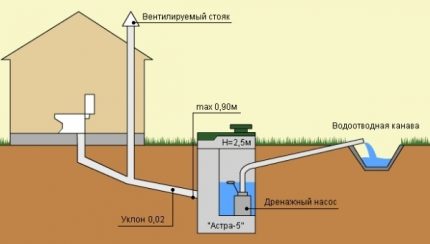
The ventilation duct going from the septic tank to the roof of the house is called fan pipe. It serves to ventilate the tank, since bacteria need air to work. With proper installation, the scents of hydrogen sulfide and methane are not scary.
According to the project, the fan riser is connected to the filtering well or directly to the extreme compartment of the septic tank.
Error No. 5: lack of high-quality thermal insulation
When installing a septic tank in winter, warming is forgotten much less often than at other times of the year. This is facilitated by negative air temperature. It is recommended to insulate a septic tank in those cases when it is not completely below the depth of freezing of the soil in order to protect the structure from freezing and damage.

It is especially important to insulate the sewage system in a country house if it will not be used for a long time in the winter - for example, in a country house. The septic tank can be “wrapped” polystyrene boards or rolled insulation.
Use heating cable for pipes, which will prevent freezing of fluid in the system. As a heater, foam crumb or expanded clay is used.
Step-by-step installation instructions for septic tanks in winter
The installation process in winter is carried out in a specific order.
Regardless of the type of septic tank, the basic steps are standard:
- pit device;
- capacity setting;
- pipe laying;
- installation of additional equipment;
- warming;
- backfilling.
Each stage is worth considering in detail.
Step 1. Pit device - size and digging method
The dimensions of the pit depend on the selected septic tank. If this concrete ring construction, its height will be 3 m, and the pit is needed deeper. Finished plastic containers may vary in height and configuration.
There are high - vertically oriented, but there are horizontal. For them, the pit will be less deep, but large in area.
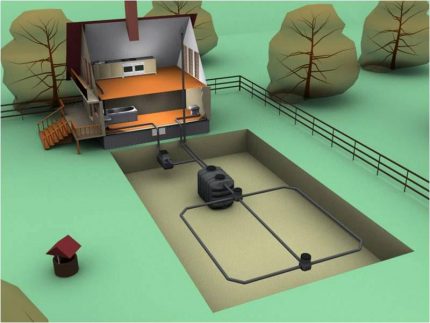
When you have decided on a place and size, you need to choose a method on how to dig a pit:
- manually by yourself;
- with the help of a construction team;
- using technique.
Since it is very difficult to dig frozen ground in winter, the first option - manually by yourself - is practically excluded. Even if you decide to dig a three-meter hole, armed with only a shovel, it will take a considerable amount of time. Therefore, such a method cannot be called rational when it comes to winter.
With the help of the labor of construction workers, the foundation pit will be dug many times faster. They have all the necessary tools, strengths, health and motivation to finish the job as quickly as possible.
Turning to qualified specialists, you will get not only the right dimensions for the pit, but also advice and practical recommendations, since builders are most likely not the first to encounter the installation of a septic tank and have some experience.
The fastest and least laborious method is to call an excavator. In this case, the process of excavation will take a few hours. A powerful machine is not afraid of frozen ground, but sometimes it has to be smashed with a jackhammer.
For the price, renting an excavator will cost even less than the construction team, but not every site can accommodate such a large equipment, and it still needs a place for maneuvers.
Step 2. Installing a septic tank - the installation process of different types
If you plan to install a septic tank of concrete rings in the winter, you need to prepare a concrete pillow at the bottom of the pit for installation. Use ready concrete rings with special locks on the edge - so wells of several elements will be more stable and tight. For installation, you have to rent a crane truck.
The rings are fastened together with cement mortar or liquid glass. Often the structure is reinforced - they put additional couplers from metal plates. All seams are carefully coated with mortar or special water-repellent mixtures on the outside and inside.
In this case, you need to pay maximum attention. waterproofing septic tank, because if a gap is formed, toxic untreated sewage will leave into the soil.
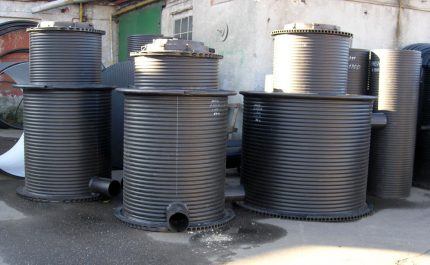
Installing a plastic septic tank in winter is simpler, because you do not have to worry about the tightness of the structure itself. However, another concern appears - consolidation.
And here, too, you need a truck crane, this time - for installing a reinforced concrete slab at the bottom of the pit. The container is fixed to the plate using metal hinges or on an anchor.
Step 3. Laying communications, ventilation, drainage
Sewer pipes are laid in trenches that connect the foundation pit to the house. Digging trenches in winter is another serious phase of excavation. The width of the trench will be several times larger than the diameter of the pipe. For the trunk, plastic pipes of 110 mm are usually taken.
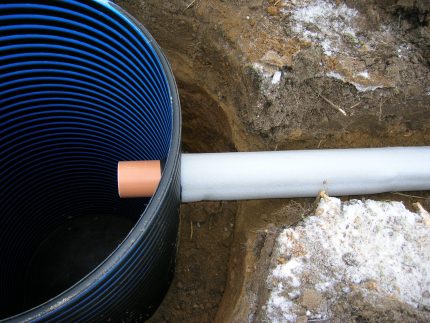
In any case, it is recommended to lay communications below the level of freezing. Already at a depth of 2 m in most regions, the temperature in winter does not fall below + 5 ° C. At this temperature, the water in the sewer will not freeze.
In addition, the drains are usually quite warm, so with regular use of the septic tank in winter, natural heating and thawing occurs.
Separately calculated filter fieldsif they are in the project. This is a pipeline going from the septic tank and distributing purified water throughout the field. Pipes are perforated and laid on a layer of sand and gravel. Sewage treated in a septic tank up to 60-70% goes to the filtration field, where it is cleaned up to 98%, passing through sand.
Drainage pipes for such a system are laid below the freezing depth of the soil in winter. For ventilation, a 90 ° corner is placed at the end of each drain and the ventilation pipe is brought to a height of about 1 m above the ground.
Step 4. An important step - external thermal insulation
For warming, the septic tank is covered with sludge and covered with a layer of material with a low coefficient of thermal conductivity, such as foam, expanded clay or penoplex. The height of the insulation layer depends on the depth of freezing and the location of the septic tank in the ground.
If the plastic will contact the frozen soil with only the upper part, the thermal insulation is designed accordingly.
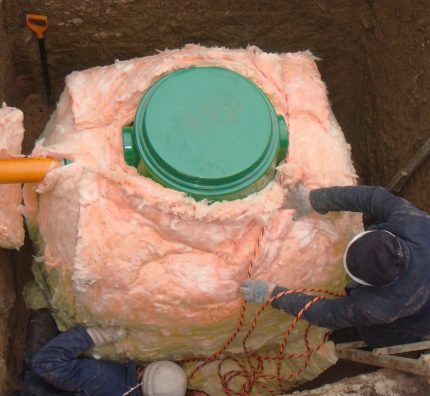
But the pipes are recommended to be insulated with roll materials, for example, mineral wool. Minvata absorbs moisture very well, which is a significant drawback in winter insulation.
In order to prevent such surprises, it is important to responsibly approach the pipe waterproofing. Use sealants for sewer networks and film materials - it is convenient to wrap pipes with them.
How to preserve a septic tank for the winter
If the septic tank is installed in the winter, but no one plans to use it yet, the system must be mothballed. It is important not to leave the structure without water for long.
A number of recommendations on how to preserve a septic tank for the winter so that it does not freeze and break, will help you do everything right and avoid mistakes:
- Disconnect and dismantle electrical equipment: pump, chopper, etc.
- Fill the septic tank with at least 70% water. If there is less water, the structure may float; if there is more, it may crack from the expansion of frozen water.
- Place a container of sand in each chamber. Plastic bottles on a rope will do. Fill them with sand, but so that the bottle retains its buoyancy. Such a simple technique will reduce the load on the case.
- Close the lid tightly and replace the thermal insulation.
If the above cannot protect the water inside the septic tank from freezing, then it can prevent equipment failure or deformation of the case.
If your sewage treatment plant is frozen, do not rush to panic.

Hot water or saline will help melt the icy pipes. Thus, you can easily and without cost bring the septic tank to life in the winter and continue to use it.
More information about the preservation of a septic tank for the winter, the rules for servicing a treatment plant in the cold season is written in the articles:
- How is septic tank preservation for the winter: step-by-step instructions
- Rules for servicing a septic tank in winter: cleaning and maintenance
Conclusions and useful video on the topic
Video clips with visual information will help you understand how to install a septic tank in the winter, as well as how to preserve it until the spring.
Installation of a plastic septic tank in winter - instructions and recommendations from a specialist:
Installation and connection of the popular model of ready-made septic tanks “Topas” in winter:
If it became necessary to preserve the septic tank until the next season, this video shows in detail how to do it.
As you can see, you should not be afraid to install a septic tank in winter. This is a normal working moment and experienced builders encounter it regularly. Now you know how to avoid most errors during installation, as well as the installation process from "A" to "Z" step by step.
Share with readers your experience in installing a treatment plant in the cold season. Please leave comments on the article, participate in discussions and ask questions of your interest. The feedback form is located below.

 Rules for servicing a septic tank in winter: cleaning and maintenance
Rules for servicing a septic tank in winter: cleaning and maintenance 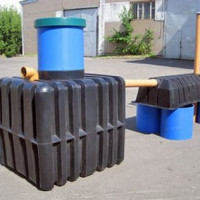 DIY septic tank installation: installation and maintenance instructions
DIY septic tank installation: installation and maintenance instructions  How is the Topop septic tank serviced in winter
How is the Topop septic tank serviced in winter  Overview of the septic tank “Flotenk”: characteristics, operating principle, installation + analysis of modifications
Overview of the septic tank “Flotenk”: characteristics, operating principle, installation + analysis of modifications  How is septic tank preservation for the winter: step-by-step instructions
How is septic tank preservation for the winter: step-by-step instructions  Installation of septic tank “Topas”: do-it-yourself installation + service rules
Installation of septic tank “Topas”: do-it-yourself installation + service rules  How much does it cost to connect gas to a private house: the price of organizing gas supply
How much does it cost to connect gas to a private house: the price of organizing gas supply  The best washing machines with dryer: model rating and customer tips
The best washing machines with dryer: model rating and customer tips  What is the color temperature of light and the nuances of choosing the temperature of the lamps to suit your needs
What is the color temperature of light and the nuances of choosing the temperature of the lamps to suit your needs  Replacement of a geyser in an apartment: replacement paperwork + basic norms and requirements
Replacement of a geyser in an apartment: replacement paperwork + basic norms and requirements
I would like to ask this question: what models of septic tanks in winter are strictly not recommended to be installed? Or can I put any? Also interested in whether such material as wood sawdust (or shavings) is suitable for warming a septic tank. It’s just that, in my opinion, I read somewhere that they are also perfectly suitable for this business. But I'm interested in the answer of a specialist.
In winter, they put any septic tanks, there are no restrictions here. The only thing is that plastic in cold weather shows cold brittleness, so you need to work with it carefully. And in the spring it will be necessary to pour the earth if it fails.
But I do not recommend warming with sawdust - they get wet, freeze and lose their thermal insulation properties. From budgetary insulation it is better to use expanded clay.
Yes, it's all clear, even windows are cheaper to install in winter. Since no one is busy with work, there is an opportunity, which they will do better, in terms of installation, and here is a septic tank. But I still tried to have everything done to me in the summer. He planned in advance, hired a brigade, waited about 2 months, so he agreed in the spring. The neighbors did it in the winter, I did not like how they installed it. As for warming, I would better advise to take polystyrene.
I installed in the winter, though we do not have severe frosts. Everything went fine. There was a problem with opening the upper frozen layer, but then just a song - nothing falls off, everything is dry. I can imagine how much dirt would be lit in the spring.